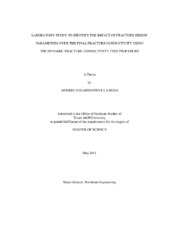| dc.contributor.advisor | Zhu, Ding | |
| dc.contributor.advisor | Hill, A. Daniel | |
| dc.creator | Pieve La Rosa, Andres Eduardo | |
| dc.date.accessioned | 2011-08-08T22:48:28Z | |
| dc.date.accessioned | 2011-08-09T01:32:31Z | |
| dc.date.available | 2011-08-08T22:48:28Z | |
| dc.date.available | 2011-08-09T01:32:31Z | |
| dc.date.created | 2011-05 | |
| dc.date.issued | 2011-08-08 | |
| dc.date.submitted | May 2011 | |
| dc.identifier.uri | https://hdl.handle.net/1969.1/ETD-TAMU-2011-05-9097 | |
| dc.description.abstract | This investigation carried out the analysis of fracture conductivity in a tight reservoir using laboratory experiments, by applying the procedure known as the dynamic fracture conductivity test. Considering the large number of experiments necessary to evaluate the effect of each parameter and the possible interaction of their combinations, the schedules of experiments were planned using a fractional factorial design. This design is used during the initial stage of studies to identify and discharge those factors that have little or no effect. Finally, the most important factors can then be studied in more detail during subsequent experiments.
The objectives of this investigation were focused on identifying the effect of formation parameters such as closure stress, and temperature and fracture fluid parameters such as proppant loading over the final conductivity of a hydraulic fracture treatment. With the purpose of estimating the relation between fracture conductivity and the design parameters, two series of experiments were performed. The first set of experiments estimated the effects of the aliases parameters. The isolated effect of each independent parameter was obtained after the culmination of the second set of experiments.
The preliminary test results indicated that the parameters with major negative effect over the final conductivity were closure stress and temperature. Some additional results show that proppant distribution had a considerable role over the final fracture conductivity when a low proppant concentration was used. Channels and void spaces in the proppant pack were detected on these cases improving the conductivity of the fracture, by creating paths of high permeability. It was observed that with experiments at temperatures around 250 degrees F, the unbroken gel dried up creating permeable scales that resulted in a significant loss in conductivity.
The results of this investigation demonstrated that dynamic fracture conductivity test procedure is an excellent tool to more accurately represent the effects of design parameters over the fracture conductivity. These results are also the first step in the development of a statistical model that can be used to predict dynamic fracture conductivity. | en |
| dc.format.mimetype | application/pdf | |
| dc.language.iso | en_US | |
| dc.subject | Dynamic Hydraulic Fracture | en |
| dc.subject | Hydraulic fracture treatment | en |
| dc.subject | Closure stress | en |
| dc.subject | Temperature | en |
| dc.subject | Proppant loading | en |
| dc.title | Laboratory Study to Identify the Impact of Fracture Design Parameters over the Final Fracture Conductivity Using the Dynamic Fracture Conductivity Test Procedure | en |
| dc.type | Thesis | en |
| thesis.degree.department | Petroleum Engineering | en |
| thesis.degree.discipline | Petroleum Engineering | en |
| thesis.degree.grantor | Texas A&M University | en |
| thesis.degree.name | Master of Science | en |
| thesis.degree.level | Masters | en |
| dc.contributor.committeeMember | Sun, Yuefeng | |
| dc.type.genre | thesis | en |
| dc.type.material | text | en |


